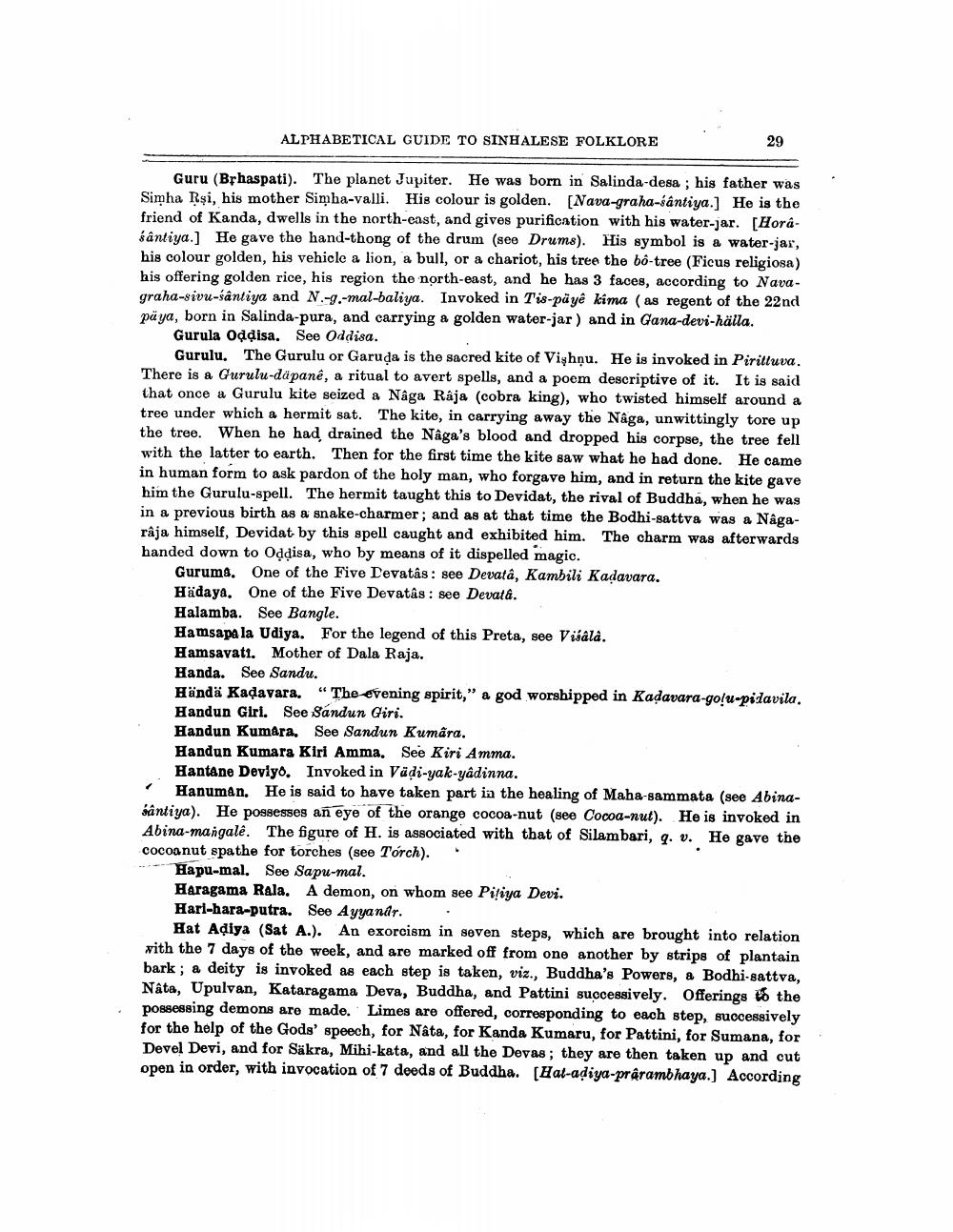________________
ALPHABETICAL GUIDE TO SINHALESE FOLKLORE
Guru (Brhaspati). The planet Jupiter. He was born in Salinda-desa; his father was Simha Rşi, his mother Simha-valli. His colour is golden. [Nava-graha-sântiya.] He is the friend of Kanda, dwells in the north-east, and gives purification with his water-jar. [Horâsântiya.] He gave the hand-thong of the drum (see Drums). His symbol is a water-jar, his colour golden, his vehicle a lion, a bull, or a chariot, his tree the bo-tree (Ficus religiosa) his offering golden rice, his region the north-east, and he has 3 faces, according to Navagraha-sivu-sântiya and N.-g.-mal-baliya. Invoked in Tis-payê kîma (as regent of the 22nd paya, born in Salinda-pura, and carrying a golden water-jar) and in Gana-devi-hälla.
Gurula Odḍisa. See Oddisa.
29
Gurulu. The Gurulu or Garuda is the sacred kite of Vishnu. He is invoked in Pirittuva. There is a Gurulu-däpanê, a ritual to avert spells, and a poem descriptive of it. It is said that once a Gurulu kite seized a Naga Rája (cobra king), who twisted himself around a tree under which a hermit sat. The kite, in carrying away the Naga, unwittingly tore up the tree. When he had drained the Nâga's blood and dropped his corpse, the tree fell with the latter to earth. Then for the first time the kite saw what he had done. He came in human form to ask pardon of the holy man, who forgave him, and in return the kite gave him the Gurulu-spell. The hermit taught this to Devidat, the rival of Buddha, when he was in a previous birth as a snake-charmer; and as at that time the Bodhi-sattva was a Nâgarâja himself, Devidat by this spell caught and exhibited him. The charm was afterwards handed down to Odḍisa, who by means of it dispelled magic.
Guruma. One of the Five Devatâs: see Devatâ, Kambili Kadavara.
Hädaya. One of the Five Devatâs: see Devatâ.
Halamba. See Bangle.
Hamsapala Udiya. For the legend of this Preta, see Visâlà.
Hamsavati. Mother of Dala Raja.
See Sandu.
Handa.
Händä Kaḍavara. "The evening spirit," a god worshipped in Kadavara-go!u-pidavila. Handun Giri. See Sandun Giri. Handun Kumara. See Sandun Kumara.
Handun Kumara Kiri Amma. See Kiri Amma.
Hantane Deviyo. Invoked in Väḍi-yak-yâdinna.
Hanuman. He is said to have taken part in the healing of Maha-sammata (see Abinasântiya). He possesses an eye of the orange cocoa-nut (see Cocoa-nut). He is invoked in Abina-mangalê. The figure of H. is associated with that of Silambari, q. v. He gave the cocoanut spathe for torches (see Torch).
Hapu-mal. See Sapu-mal.
Haragama Rala. A demon, on whom see Pitiya Devi.
Hari-hara-putra. See Ayyanar.
Hat Adiya (Sat A.). An exorcism in seven steps, which are brought into relation with the 7 days of the week, and are marked off from one another by strips of plantain bark; a deity is invoked as each step is taken, viz., Buddha's Powers, a Bodhi-sattva, Nâta, Upulvan, Kataragama Deva, Buddha, and Pattini successively. Offerings to the possessing demons are made. Limes are offered, corresponding to each step, successively for the help of the Gods' speech, for Nâta, for Kanda Kumaru, for Pattini, for Sumana, for Devel Devi, and for Säkra, Mihi-kata, and all the Devas; they are then taken up and cut open in order, with invocation of 7 deeds of Buddha. [Hal-aḍiya-prarambhaya.] According




